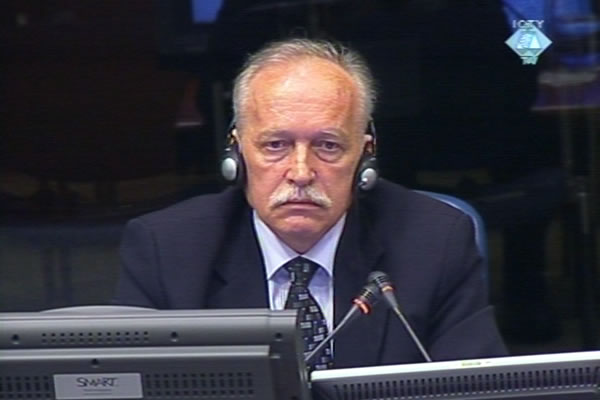Home
TIME OF DISARRAY AND CHAOS IN ILIDZA
Radomir Kezunovic, the first president of the Serb municipality of Ilidza, confirmed in his evidence at the trial of Radovan Karadzic that in the first months of war, various paramilitary formations arrived in Ilidza. Among them were Seselj’s men headed by Brne Gavrilovic, Arkan’s Tigers and their leader Milorad Lukovic Legija and Bokan’s group. According to the witness, it was ‘a time of absolute disarray and chaos in Ilidza’
 Radomir Kezunovic, witness at the Radovan Karadzic trial
Radomir Kezunovic, witness at the Radovan Karadzic trial After a two-month break, the trial of former Republika Srpska president Radovan Karadzic resumed today with the evidence of Radomir Kezunovic. After the multi-party elections in BH in 1990, Kezunovic was appointed president of the Executive Board of the Ilidza Municipal Assembly. The witness’s written statement based on his previous statements to the OTP and his evidence at the trial of Mico Stanisic and Stojan Zupljanin in July 2010 was admitted into evidence.
Before the war broke out, Kezunovic was the president of the Serb municipality of Ilidza, proclaimed in January 1992, and served as the president of the Crisis Staff until the end of April 1992 when he handed over the duty to Nedjeljko Prstojevic. In his statement, the witness described the structure and the flow of information system in the Serbian Democratic Party. Kezunovic explained that Karadzic and Krajisnik were the party ‘leaders’ and that Ilidza was the last municipality where the hostilities broke out: it happened only after all efforts to divide the territory peacefully failed.
In the examination-in chief, the prosecution showed a video recording of a rally near Novakova Pecina on Mount Romanija on 6 May 1991. Vojislav Seselj addressed the people and spoke about the newly attained ‘Serb accord and unity’. ‘Serb Chetnik units will operate’ in all parts of ‘Western Serbia – in the Serbian Krajina, Serbian Slavonia, Baranja and Western Srem’, he added. They would not surrender a single square foot of Serbian land east of the Karlobag-Ogulin-Karlovac-Virovitica line, Seselj said. At the rally, Karadzic spoke about the dangers lurking in the ‘militarized Croatia’. This was ‘top news item that day’ in the Sarajevo media, the witness said.
Answering the questions asked by prosecutor Carolyn Edgerton, the witness confirmed that in the first months of war, people from the outside arrived in Ilidza wearing various kinds of uniforms. Among them were Seselj’s men, and members of the groups led by Brne Gavrilovic, Milorad Lukovic Legija and Bokan. According to Kezunovic, they engaged in ‘weekend combat’ and would not stay longer than ten days. They then left with the goods they had looted. It was the ‘time of absolute disarray and chaos’, the witness said.
In the cross-examination, Karadzic used intercepted conversations in an effort to show that he and the SDS ‘were always and categorically opposed to any formations’ apart from the army. The witness didn’t want to comment on the intercepts saying only that he had an opportunity to hear Karadzic express such views. Kezunovic agreed with Karadzic that the village of Sokolovic kolonija was built on the ‘Serb land’. Nevertheless, Kezunovic added that the ‘truth was that there was no forcible takeover of the land’; Muslims from Sandzak bought land from local Serbs.
Karadzic asked the witness to confirm his argument that the document called Variant A and B on the takeover of power in a number of municipalities by the Serb forces had in fact been drafted by some retired JNA officers as a ‘preventive measure against ethnic slaughter’. Karadzic went on to ask the witness whether he saw ‘the old communist mentality’ reflected in that document. The witness agreed and said that his comments on that ‘paper’ were based on ‘knowledge after the fact’, because he hadn’t seen the document during the war. Kezunovic only heard that such document existed.
Karadzic also tried to prove that the Crisis Staff in Ilidza was not ‘an engine of ethnic cleansing’ or part of some joint criminal enterprise: the crisis staffs were established as a matter of course after natural disasters, like floods. Kezunovic agreed with Karadzic, saying that as far as he knew the Crisis Staff had never made any illegal decisions. The witness also agreed with Karadzic that Ilidza was surrounded by ‘Muslim forces’ and concluded that the municipality was ‘under siege just like the federal Sarajevo’.
Linked Reports
- Case : Karadzic
- 2011-05-24 KARADZIC WANTS UNHCR DOCUMENTS
- 2011-05-13 KARADZIC’S MOTION ‘PREMATURE’
- 2011-05-10 KARADZIC SEEKS DOCUMENTS ABOUT ‘INFORMAL CONSULTATIONS’ IN SECURITY COUNCIL
- 2011-06-01 KARADZIC ‘ACTIVELY’ USED HIS POWER
- 2011-06-02 KARADZIC'S NAME-SWITCHING GAME
- 2011-06-06 WITNESS: KARADZIC ‘EXPECTED OBEDIENCE’
